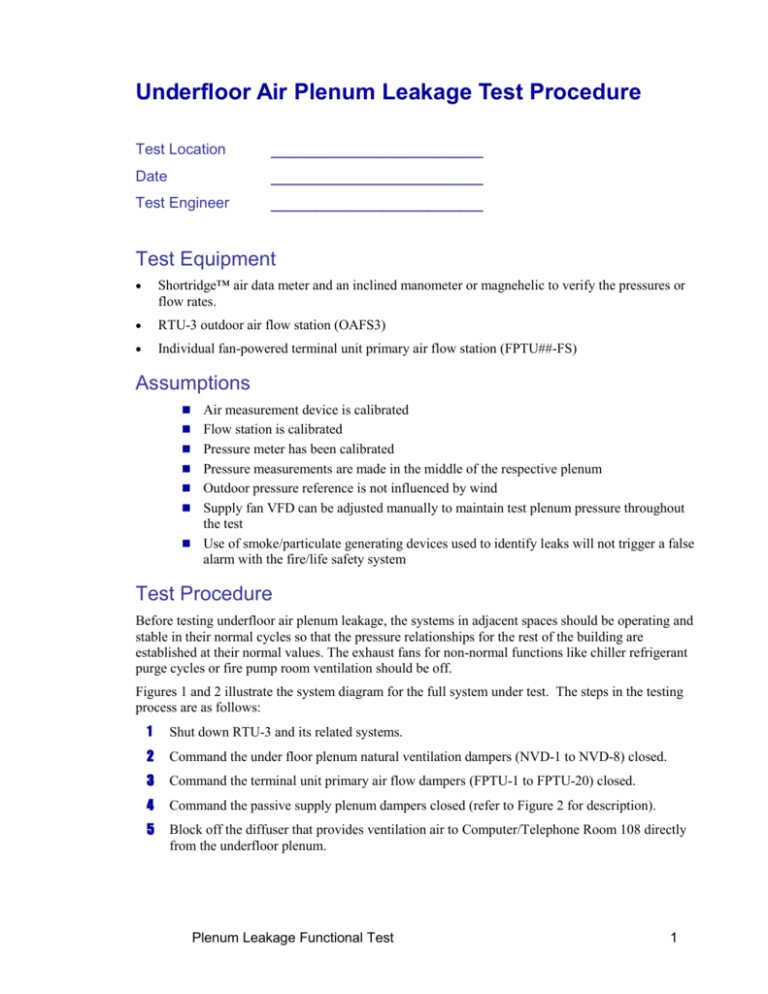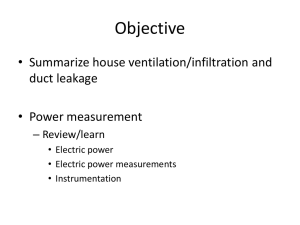Plenum Leakage Test - Functional Testing and Design Guides
advertisement

Underfloor Air Plenum Leakage Test Procedure Test Location Date Test Engineer ___________________ ___________________ ___________________ Test Equipment Shortridge™ air data meter and an inclined manometer or magnehelic to verify the pressures or flow rates. RTU-3 outdoor air flow station (OAFS3) Individual fan-powered terminal unit primary air flow station (FPTU##-FS) Assumptions Air measurement device is calibrated Flow station is calibrated Pressure meter has been calibrated Pressure measurements are made in the middle of the respective plenum Outdoor pressure reference is not influenced by wind Supply fan VFD can be adjusted manually to maintain test plenum pressure throughout the test Use of smoke/particulate generating devices used to identify leaks will not trigger a false alarm with the fire/life safety system Test Procedure Before testing underfloor air plenum leakage, the systems in adjacent spaces should be operating and stable in their normal cycles so that the pressure relationships for the rest of the building are established at their normal values. The exhaust fans for non-normal functions like chiller refrigerant purge cycles or fire pump room ventilation should be off. Figures 1 and 2 illustrate the system diagram for the full system under test. The steps in the testing process are as follows: 1 Shut down RTU-3 and its related systems. 2 Command the under floor plenum natural ventilation dampers (NVD-1 to NVD-8) closed. 3 Command the terminal unit primary air flow dampers (FPTU-1 to FPTU-20) closed. 4 Command the passive supply plenum dampers closed (refer to Figure 2 for description). 5 Block off the diffuser that provides ventilation air to Computer/Telephone Room 108 directly from the underfloor plenum. Plenum Leakage Functional Test 1 Steps 2-5 should completely isolate the underfloor plenum so that there is no flow path out of it and the only flow path into it is through the RTU-3 supply duct. This configuration will allow us to use the RTU-3 supply fan to pressurize it. 6 Command the RTU-3 return dampers fully closed. 7 Command the ceiling plenum relief dampers (NVRD-1 to NVRD-10) fully closed. Steps 6 and 7 should completely isolate the occupied space and ceiling return plenum so that there is no flow path into or out of it. This configuration will allow us to open the terminal unit primary air dampers after the under floor plenum test and use the RTU-3 supply fan to pressurize the under floor plenum, the occupied space, and the ceiling plenum. 8 Command the RTU-3 outdoor air dampers fully open. 9 Place the RTU-3 supply fan VFD in a mode that will allow manual control the fan speed. 10 Set the fan speed to 0 Hz. 11 Start the supply fan and gradually increase the fan speed until the plenum reaches a pressure of 0.2 inches w.c. (the maximum operating pressure anticipated by the design.). Measure pressure somewhere in the middle of the plenum. 12 Document the outdoor air flow rate at this setting. This is the plenum leakage rate. If it seems excessive, then the air leak needs to be pinpointed so it can be fixed. Leaks can be identified by physical inspection, using a borozin gun, smoke sticks, or other smoke generator device. Note that use of a borozin gun, smoke sticks, or other smoke generator device may trigger the fire alarm system. The proper authorities must be contacted and alerted to a potential false alarm prior to using these devices to help identify the source of a leak. 13 After documenting the leakage rate, begin opening terminal unit primary air flow dampers one at a time. Open a damper, wait for stabilization and then increase the supply fan speed until the under floor plenum pressure is back to 0.2 inches w.c. 14 If the pressure in the occupied space relative to the outside is less than 0.05 inches w.c. (design pressure differential setpoint), then open another terminal unit primary air valve and repeat steps 13 and 14 until a condition is reached where the under floor plenum is at 0.2 inches w.c. relative to atmosphere and the occupied space is at 0.05 inches w.c. relative to atmosphere. 15 When the required test condition is reached document the current outdoor air flow rate. This is the overall leakage rate for both the underfloor plenum and occupied/return space. 16 Document the primary air flow rate through the fan terminal unit air flow dampers that are open. This is the leakage rate for the occupied space and ceiling return plenum. It should be very close to the number of the under floor plenum leakage rate from step 12 subtracted from the current outdoor air flow rate documented in step 15. 17 If this rate is excessive, then the air leak should be pinpointed so it can be fixed. Leaks can be identified by physical inspection, using a borozin gun, smoke sticks, or other smoke generator device. Note that use of a borozin gun, smoke sticks, or other smoke generator device may trigger the fire alarm system. The proper authorities must be contacted and alerted to a potential false alarm prior to using these devices to help identify the source of a leak. 18 Return system to normal operating conditions by enabling correct time and schedules, releasing all override commands, opening and/or unsealing all diffusers, and setting system operating parameters to the values specified in the design sequence of operations. Plenum Leakage Functional Test 2 Figure 1 – System Diagram for the Plenum Leakage Test Measure pressure in the middle of the plenum Measure pressure in the middle of the plenum Plenum Leakage Test Procedure 3 Figure 2 – Continuation of the System Diagram for the Plenum Leakage Test Plenum Leakage Test Procedure 4








